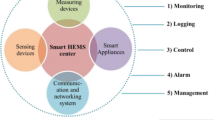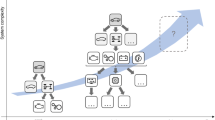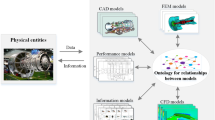Abstract
Design criteria for distributed and pervasive intelligent systems, such as Multi Agent Systems (MAS), are generally led by the functional decomposition of the given application-dependent knowledge. Consequently, changes either in the problem semantics or in the granularity level description may have a significant impact on the overall system re-engineering process. In order to tackle better these issues, a novel framework called Hierarchical-Granularity Holonic Model (HGHM) is introduced as a holon-based approach to distributed intelligent systems modelling. A holon is an agent endowed with special features. Seen from the outside, a holon behaves like an intelligent agent; seen from the inside, it appears to be decomposable into other holons. This property allows for modelling complex distributed systems at multiple hierarchical-granularity levels by exploiting the different abstraction layers at which the design process is carried out. The major benefit of the proposed approach against traditional holonic systems and MAS is that the entire HGHM-based architecture can be derived directly from the problem ontology as a hierarchical composition of self-similar, modular blocks. This helps designers focussing more on knowledge representation at different granularity levels which is a very basic process, as in top–down problem decomposition. Starting from the literature on holonic systems, a theoretical model of HGHM is introduced and an architectural model is derived accordingly. Finally, a customized application for the case study of distributed indoor air quality monitoring systems is commented and improvements in terms of system design with respect to well-established solutions are considered.








Similar content being viewed by others
References
Abilemona R, Petriu EM, Whalen TE (2010) Distributed intelligent sensor agent system for environment mapping. J Ambient Intell Hum Comput 1(2):95–110. doi:10.1007/s12652-010-0010-6
Acampora G, Loia V (2005) Fuzzy control interoperability and scalability for adaptive domotic framework. IEEE Trans Ind Inform 1(2):97–111
Acampora G, Loia V (2008) A proposal of ubiquitous fuzzy computing for ambient intelligence. Inf Sci Int J 178(3):631–646
Adam E, Mandiau R, Kolski C (2000) HOMASCOW: a holonic multi-agent system for cooperative work. In: Proceedings of the 11th international workshop on database and expert systems applications, pp 247–253
Bellifemine F, Poggi A, Rimassa G (2001) Developing multi-agent systems with JADE, Lecture notes in computer science. Springer, Berlin, pp 42–47
Berners-Lee T, Hendler J, Lassila O (2001) The Semantic Web, Scientific American, pp 29–37
Biswas PK (2005) Architecting multi-agent systems with distributed sensor networks. In: Proceedings of KIMAS 2005, Waltham, MA, USA, pp 161–166, 18–21 April 2005
Bocchio V, Masoero M (1992) CH4, Energia, Metano, 2:15–20
Cheng TT, Yang HC, Lin JY, Hung MH (2001) The development of holonic information coordination systems with security considerations and error-recovery capabilities. Proc IEEE Conf Robot Autom 2:1832–1838
Christensen JH (1994) Holonic manufacturing systems: initial architecture and standards directions. In: Proceedings of the 1st Euro workshop on holonic manufacturing systems, HMS Consortium, Hannover, Germany, 1 December 1994
Christensen JH (2007) IEC 61499: a standardized architecture for adding value in industrial automation. In: Kitara seminar, HTC High Tech Center. Available at www.holobloc.com
Clegg BT (2007) Building a holarchy using business process-oriented holonic (PrOH) modelling. IEEE Trans Syst Man Cybern Part A Syst Hum 37(1):23–40
Colombo AW, Schoop R, Neubert R (2006) An agent-based intelligent control platform for industrial holonic manufacturing systems. IEEE Trans Ind Electron 53(1):322–337
Dai Z, Sun B, Wang H, Li Y (2008) A three-layer cooperative knowledge modeling of multi-agent conflict system based on healthcare sensor decision network. In: Proceedings of 2008 international symposium on knowledge acquisition and modeling, pp 157–160
Davis R, Shrobe H, Szolovits P (1993) What is a knowledge representation? AI Mag 14(1):17–33
Di Lecce V, Amato A, Pasquale C, Piuri V (2005) Web agents in an environmental monitoring system. In: IEEE international conference on computational intelligence for measurement systems, Giardini Naxos, Italy, pp 262–265
Di Lecce V, Amato A, Calabrese M (2008) Decision trees in time series reconstruction problems. In: IEEE International instrumentation and measurement technology conference, Vancouver, Canada, pp 895–899, 12–15 May 2008
Di Lecce V, Calabrese M, Piuri V (2009a) An ontology-based approach to human telepresence. In: IEEE conference on computational intelligence for measurement systems and applications, Hong Kong, China, pp 56–61, 11–13 May 2009
Di Lecce V, Calabrese M, Soldo D (2009b) Fingerprinting lexical contexts over the Web. J Univers Comput Sci 15(4):805–825
Di Lecce V, Calabrese M, Soldo D (2009c) A semantic lexicon-based approach for sense disambiguation and its WWW application. In: Proceedings of the ICIC 2008 conference, published in Lecture Notes in Computer Science, vol 5755. Springer, Berlin, pp 468–477
Fellbaum C (1998) WordNet. An electronic lexical database. MIT Press, Cambridge, MA
Fleetwood M, Kotak DB, Shaohong Wu Tamoto H (2003) Holonic system architecture for scalable infrastructures. Proc IEEE Int Conf Syst Man Cybern 2:1469–1474
Fletcher M, Deen SM (2001) Fault-tolerant holonic manufacturing systems, concurrency and computation: practice and experience. Special Issue High Perform Agent Syst 13(1):43–70
Fletcher M, Garcia-Herreros E, Christensen JH, Deen SM, Mittmann R (2000) An open architecture for holonic cooperation and autonomy. In: Proceedings of the 11th international workshop on database and expert systems applications, pp 224–230
Flores-Mendez RA (1999) Towards a standardization of multi-agent system framework. Crossroads 5(2):18–24
Fujita N (2001) Holonic controller and assembly task planning. In: Proceedings of the IEEE international symposium on assembly and task planning, pp 67–72
Giret A, Botti V (2004) Holons and agents. J Intell Manuf 15:645–659
Gruber TR (1995) Toward principles for the design of ontologies used for knowledge sharinge. Int J Hum Comput Stud 43:907–928
Koestler A (1971) The ghost in the machine. Arkana Books, Carneige-Mellon University
Kremer R, Norrie D (2000) Architecture and design of a holonic visual interface. Proc IEEE Conf Syst Man Cybern 3:1715–1720
Leitão P, Restivo F (2008) Implementation of a holonic control system in a flexible manufacturing system. IEEE Trans Syst Man Cybern Part C 38(5):699–709
Meyer B (2009) Touch of class: learning to program well with object and contracts, Springer
Navigli R, Velardi P (2005) Structural semantic interconnections: a knowledge-based approach to word sense disambiguation. IEEE Trans Patter Anal Mach Intell 27(7):1075–1086
Okamoto S, Scerri P, Sycara K (2008), The impact of vertical specialization on hierarchical multi-agent systems. In: Proceedings of the 23rd AAAI conference on artificial intelligence, pp 138–143
Russell S, Norvig P (2002) Artificial intelligence: a modern approach. 2nd edn. Prentice Hall
Shafaei S, Aghaee NG (2008) Biological network simulation using holonic multiagent systems. In: Tenth international conference on computer modelling and simulation, pp 617–622
Simão JM, Stadzisz PC (2009) Inference based on notifications: a holonic metamodel applied to control issues. IEEE Trans Syst Man Cybern Part A 39(1):238–250
Simão JM, Tacla CA, Stadzisz PC (2009) Holonic control metamodel. IEEE Trans Syst Man Cybern Part A 39(5):1126–1139
Sycara KP (1998) Multiagent systems. AI Mag 19(2):79–92
Tannenbaum AS (2006) Structured computer organization. 5th edn. (c) 2006 Pearson Education
Thompson D, Hughes DR (1998) Holonic modelling. Manuf Eng 77(3):116–119
Tichy P, Slechta P, Staron RJ, Maturana F, Hall KH (2005) Multiagent technology for fault tolerance and flexible control. IEEE Trans Syst Man Cybern C Appl Rev 36(5):700–705
Ulieru M, Este RA (2004) The holonic enterprise and theory emergence: on emergent features of self-organization in distributed virtual agents. Cybern Hum Knowing 11(1):79–98
Van Dyke Parunak H, Odell J (2002) Representing social structures in UML. In: International workshop on agent-oriented software engineering, vol 2222. Montreal PQ, Canada, pp 1–16
Walker SS, Brennan RW, Norrie DH (2005) Holonic job shop. Scheduling using a multiagent system. IEEE Intell Syst 2:50–57
Wooldridge M, Jennings NR (1995) Intelligent agents: theory and practice. Knowl Eng Rev 10(2):115–152
Xiaokun Z, Norrie DH (1999) Dynamic reconfiguration of holonic lower level control. In: Proceedings of the second international conference on intelligent processing and manufacturing of materials, vol 2. pp 887–893
Acknowledgments
The authors would like to thank the anonymous reviewers whose proposals and comments helped us improve the overall paper quality.
Author information
Authors and Affiliations
Corresponding author
Rights and permissions
About this article
Cite this article
Calabrese, M., Amato, A., Lecce, V.D. et al. Hierarchical-granularity holonic modelling. J Ambient Intell Human Comput 1, 199–209 (2010). https://doi.org/10.1007/s12652-010-0013-3
Received:
Accepted:
Published:
Issue Date:
DOI: https://doi.org/10.1007/s12652-010-0013-3




